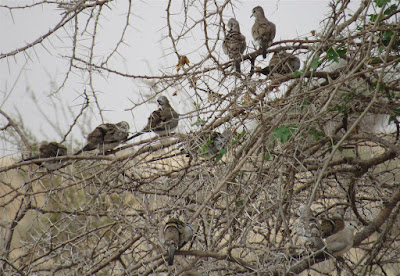We went south to the closest place to Nouakchott which is consistantly affected by summer rains. This is Amzela which is just over 70 kilometres south of Nouakchott.
On our visit last October there were birds which are not seen any further north.
We hoped for the same this time round.
The signs were good. The watering hole had water and this is caused by rain unlike most surface water in Nouakchott.
There are several large trees clustered around the watering hole and most are natural.
The first tree we approached was a good start. A migrant pied flycatcher was making sorties.
pied flycatcher
At the top of the tree a Viellot's barbet was calling loudly.
Viellot's barbet
As we moved slowly round the large pool, not one but two cuckoos flushed from a distant tree. They flew in opposite directions. One was a great spotted cuckoo. The other was a pied cuckoo.
These were exactly the type of birds we had hoped for.
We had seen a great spotted cuckoo at Lake Ganky in late October last year. This one could either have been a European migrant going south or a rainy season African breeder heading north!
We never did get prolonged looks as it was very furtive.
pied cuckoo from below
The pied cuckoo was a really good find. It is out of range according to the distribution maps but was an entirely reasonable find once you know that Amzela is the northern most point of wetland Sahel habitat in the country.
We diverted our attention from the bird to search more widely away for the water and trees for a while.
northern anteater chat
Noisy northern anteater chat were seen and heard out in the open. This is certainly on the northern edge of their range too. Blue-cheeked bee-eater were hawking overhead but were reluctant to land.
I was keen to get good pictures of the pied cuckoo so we returned to it soon enough.
While "stalking" it we came across green-backed camaroptera and nightingale low in the same very large tree that it was in at the time.
pied cuckoo 1
pied cuckoo 2
Elsewhere there was a flock of 12 white-billed buffalo weaver. A solitary greater blue-eared starling joined them from time to time.
white-billed buffalo-weaver
Amzela always has very large numbers of Namaqua dove. This time, one stood out. It appeared to be a partially leucistic bird.
Leucistic namaqua dove (right)
A quick search on the internet gave me no incidences of this phenomenon but I cannot believe this is the first time this has been observed.
Leucistic namaqua dove 2
It was part of a large group and seemed to be accepted by them well enough.
leucistic namaqua dove 3
There were plenty of migrant warblers present. These included willow warbler and western bonelli's warbler. Most warblers were seen in the trees.
sedge warbler
However, a few were in adjacent bushes including a sedge warbler in tamarisk.
hoopoe
Other notable birds were hoopoe and black bush robin.
rear view of black bush robin
African silverbill
Just before we left we came across 20 Namaqua dove in one bush.
Namaqua dove in a bush
Half way back towards the city is the water plant in Riyadh district. There is a very short artifical river coming out of the back of the plant. Though the cover is mostly Sodom's apple, this spot can attract many birds particularly those seeking water.
Since our last visit, clearly some city people have now discovered this spot. There were too many people there to allow birds to settle as well as they wanted. A visit in a weekday could probably be more fruitful.
cattle egret
Crucially though we spotted a Eurasian cuckoo twice. It never really settled and was last seen continuing its migration south.
It was, however, species 264 on my Mauritanian list. Sunday was truly the day of the cuckoos.
Species seen at Amzela on August 13th
Little Stint
Common Sandpiper
Laughing Dove
Namaqua Dove
Great Spotted Cuckoo
Pied Cuckoo
Blue-naped Mousebird
Eurasian Hoopoe
Blue-cheeked Bee-eater
Vieillot's Barbet
Southern Grey Shrike
Woodchat Shrike
Pied Crow
Black-crowned Sparrow-Lark
Crested Lark
Willow Warbler
Common Chiffchaff
Western Bonelli's Warbler
Western Olivaceous Warbler
Melodious Warbler
Sedge Warbler
Eurasian Reed Warbler (Eurasian)
Green-backed Camaroptera (Grey-backed)
Cricket Longtail
Black Scrub-Robin
Common Nightingale
European Pied Flycatcher
Northern Anteater-Chat
Greater Blue-eared Starling
Sudan Golden Sparrow
White-billed Buffalo-Weaver
African Silverbill
Species seen outside the water plant, Riyadh district, Nouakchott on August 13th
Great White Pelican
Grey Heron
Little Egret
Cattle Egret (Western)
Squacco Heron
Little Stint
Common Sandpiper
Green Sandpiper
Wood Sandpiper
Laughing Dove
Namaqua Dove
Common Cuckoo
Blue-naped Mousebird
Eurasian Hoopoe
Blue-cheeked Bee-eater
Southern Grey Shrike
Woodchat Shrike
Pied Crow
Black-crowned Sparrow-Lark
Crested Lark
Barn Swallow
House Sparrow

















No comments:
Post a Comment